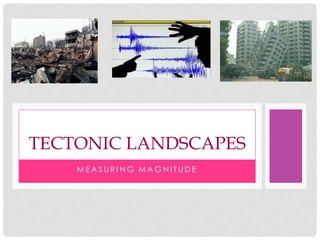
4. measuring activity
- 1. TECTONIC LANDSCAPES MEASURING MAGNITUDE
- 2. SPECIFICATION DETAIL • 3.1d The measurement of earthquake magnitude (the Mercalli and Richter scales). • Diagrams showing the characteristics of focus and epicentre.
- 3. LEARNING OBJETIVES • Know the differences between the Mercalli (intensity) and Richter (magnitude) scales. • Explain how earthquakes occur with reference to the epicentre and focus of earthquakes.
- 4. DEFINITIONS • Watch Seismograph: Here • Mercalli scale: (intensity) Uses seismic scale to measure the intensity of an earthquake. It is used to measure the effects of an earthquake. • Richter scale: (magnitude) A logarithmic scale used to express the total amount of energy released by an earthquake (It is a base 10 logrimithic scale: e.g. 5.0 on the Richter scale has a shaking amplitude 10 times larger than one that measures 4.0, ) assign a single number to quantify the energy released during an earthquake.
- 5. HOW ARE EARTHQUAKES MEASURED? The Richter scale can be used to measure the magnitude (power) of a tremor using an instrument called a seismograph. It is a logarithmic scale which means that a size ‘6’ earthquake on the Richter scale is 10 times larger than a size ‘5’ and 100 times larger than a size ‘4’.
- 6. HOW DOES A SEISMOGRAPH WORK?
- 7. THE MERCALLI SCALE The Mercalli scale rates an earthquake's magnitude based on observations of the damage it causes on a scale of 1 to 12. Items shake from Buildings collapse: shelves: scale 5 scale 10
- 8. Richter Scale Intensity Magnitude Observations (Mercalli) (Mercalli) (approx. comparison) I No effect 1 to 2 II Noticed only by sensitive people 2 to 3 III Resembles vibrations caused by heavy traffic 3 to 4 IV Felt by people walking; rocking of free standing objects 4 V Sleepers awakened; bells ring 4 to 5 VI Trees sway, some damage from falling objects 5 to 6 VII General alarm, cracking of walls 6 VIII Chimneys fall and some damage to building 6 to 7 IX Ground crack, houses begin to collapse, pipes break 7 X Ground badly cracked, many buildings destroyed. Some landslides 7 to 8 XI Few buildings remain standing, bridges destroyed. 8 XII Total destruction; objects thrown in air, shaking and distortion of ground 8 or greater
- 9. TASK: SORTING • Using the following statements, sort them into which best describes the scales. • Here
- 10. Richter Scale Intensity Magnitude Observations (Mercalli) (Mercalli) (approx. comparison) I No effect 1 to 2 II Noticed only by sensitive people 2 to 3 III Resembles vibrations caused by heavy traffic 3 to 4 IV Felt by people walking; rocking of free standing objects 4 V Sleepers awakened; bells ring 4 to 5 VI Trees sway, some damage from falling objects 5 to 6 VII General alarm, cracking of walls 6 VIII Chimneys fall and some damage to building 6 to 7 IX Ground crack, houses begin to collapse, pipes break 7 X Ground badly cracked, many buildings destroyed. Some landslides 7 to 8 XI Few buildings remain standing, bridges destroyed. 8 XII Total destruction; objects thrown in air, shaking and distortion of ground 8 or greater
- 11. TASK: WATCH THESE CLIPS • Tachoma, Japan earthquake: Here • Chilean earthquake: Here • Kashima, Japan earthquake: Here • Tokyo, Japan earthquake: Here • Maryland, USA earthquake: Here Which scale was the most easy to use? Why?
- 12. EXAM PRACTISE • Describe 2 differences between the Mercalli and Richter scale. (2 marks) One difference is ………… A second difference is that……………
- 13. LEARNING OBJETIVES • Know the differences between the Mercalli (intensity) and Richter (magnitude) scales. • Explain how earthquakes occur with reference to the epicentre and focus of earthquakes.
- 14. EPICENTRE • Epicentre on google earth: here • Interactive : Here
- 16. EXAM QUESTION • Outline a difference between the focus and epicentre of an earthquake. (2marks)
- 17. LEARNING OBJETIVES • Know the differences between the Mercalli (intensity) and Richter (magnitude) scales. • Explain how earthquakes occur with reference to the epicentre and focus of earthquakes.